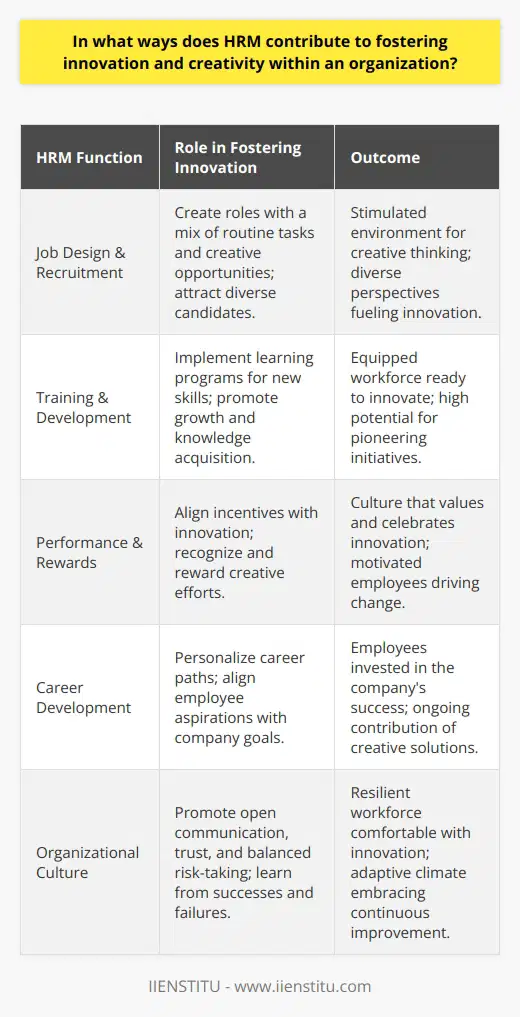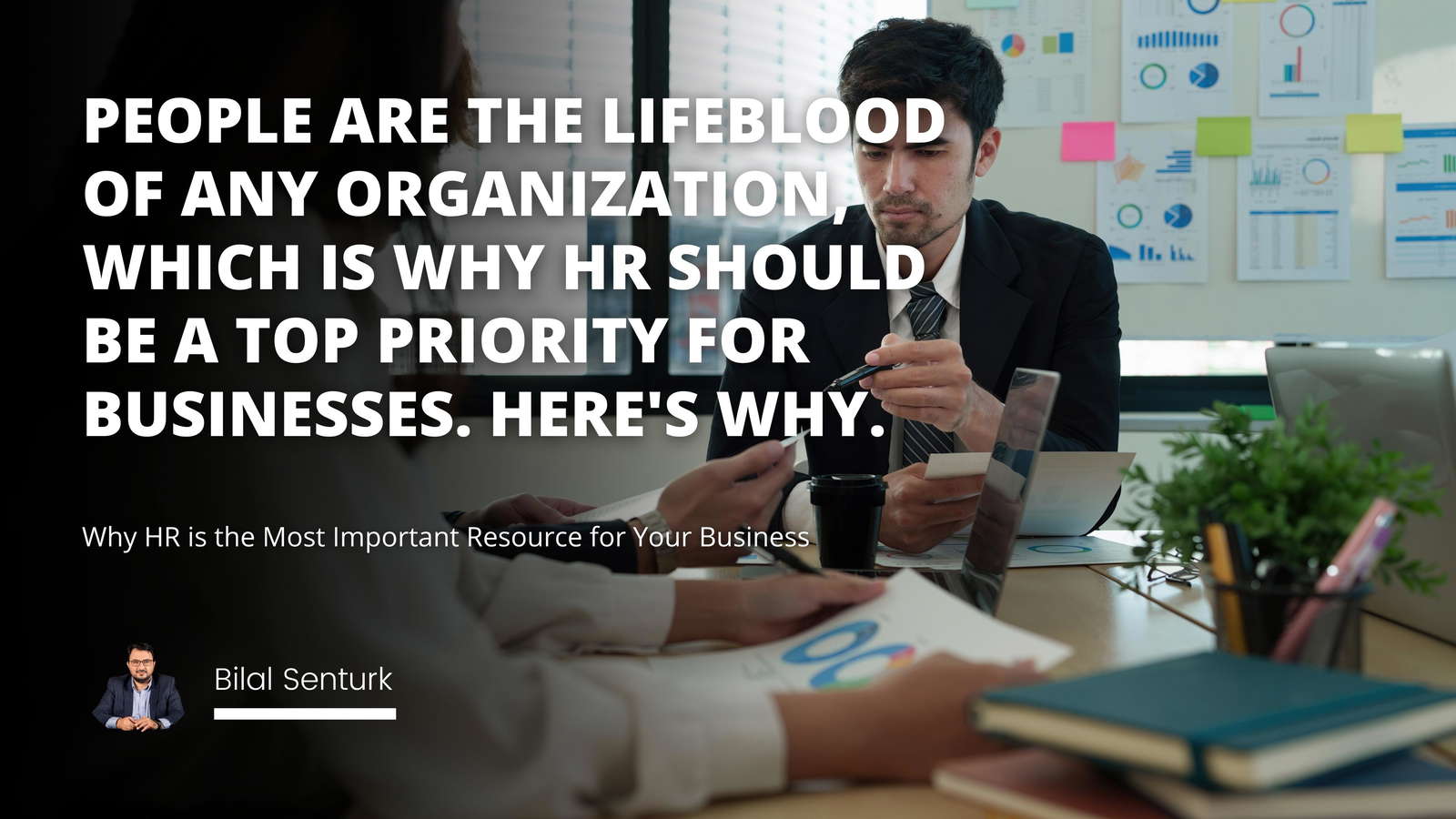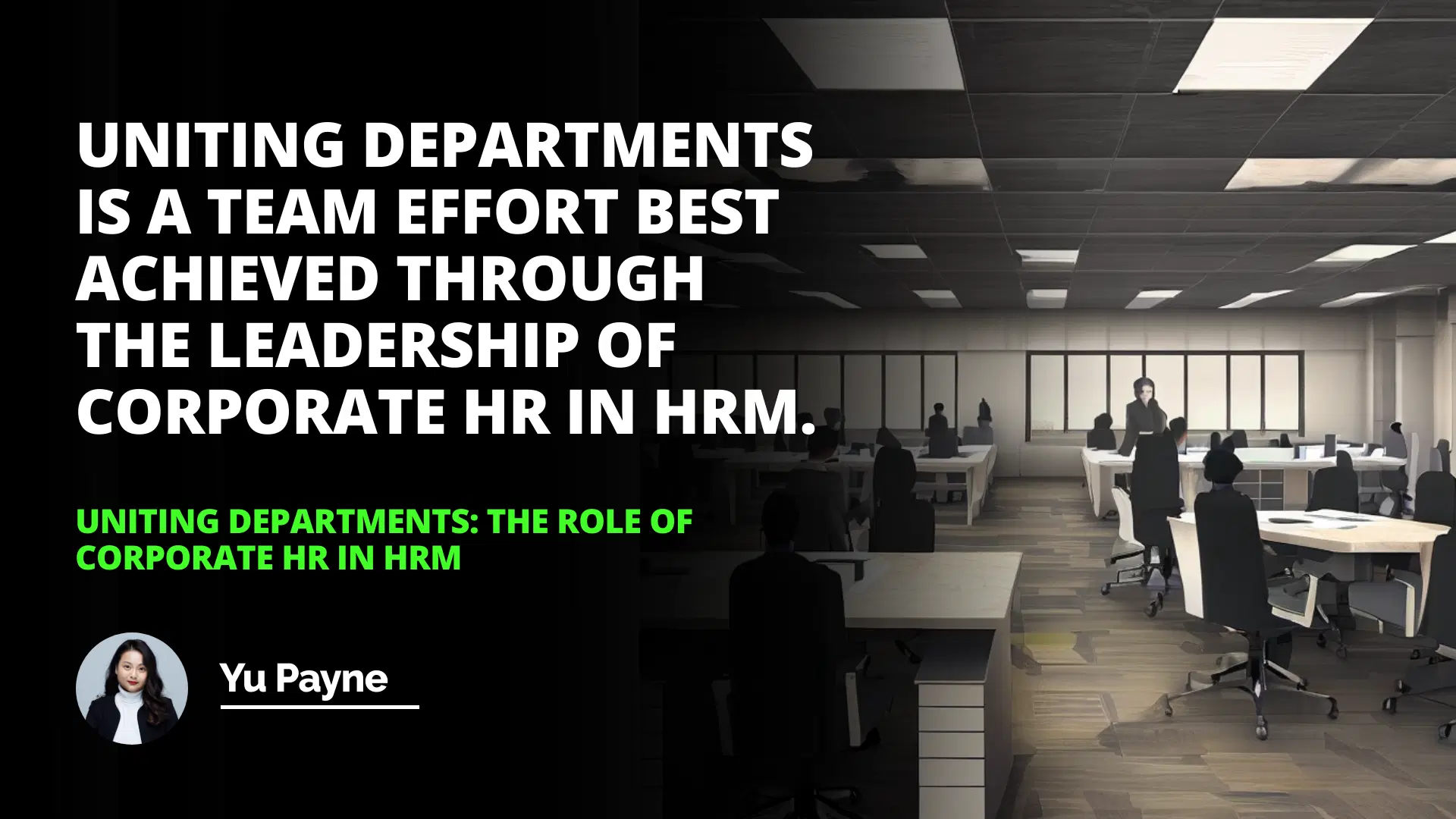
It is also responsible for creating and maintaining a cohesive organizational culture and setting the tone for the organization's objectives. In addition, corporate HR is a specialist service department responsible for providing the necessary resources and support to ensure that all departments work together to achieve the organization's goals. It is also responsible for ensuring that all legal requirements and compensation policies are met and that the organization's future workforce planning is adequate.
Introduction
The Relationship of Corporate HR with Different Departments
Role of Corporate HR
Corporate HR as a Specialist Service Department
Conclusion
Introduction: The relationship of Corporate HR with different departments is essential to any organization's success. Corporate HR provides the necessary resources and support to ensure that all departments work together to achieve the organization's goals.
It is also responsible for creating and maintaining a cohesive organizational culture and setting the tone for the organization's objectives. This article will discuss the role of Corporate HR in different departments, its role as a specialist service department, and its importance in creating a unified organizational culture.
The Relationship of Corporate HR with Different Departments
The relationship of Corporate HR with different departments is complimentary. For instance, the marketing department is responsible for understanding the current business environment and providing insight into potential opportunities and challenges.
On the other hand, the finance department is responsible for providing an understanding of the organization's financial status, the impact of the share market on the organization's shareholders, and the need for collaboration between different departments and financial needs. Corporate HR is responsible for bringing these two departments together and ensuring that all requirements are met effectively and efficiently.
Role of Corporate HR
The role of Corporate HR is to provide the necessary resources and support to ensure that all departments work together to achieve the organization's goals. In addition, corporate HR is responsible for creating and maintaining an organizational culture conducive to achieving the organization's objectives.
This includes setting the tone for the organization's goals, ensuring that all departments work together, and creating a unified organizational culture. Corporate HR is also responsible for ensuring that all legal requirements and compensation policies are met and that the organization's future workforce planning is adequate.
Corporate HR as a Specialist Service Department
Corporate HR is a specialist service department responsible for providing the necessary resources and support to ensure that all departments work together to achieve the organization's goals. In addition, corporate HR is responsible for setting the tone for the organization's objectives and creating a unified organizational culture.
It is also responsible for ensuring that all legal requirements and compensation policies are met and that the organization's future workforce planning is adequate. Corporate HR is also responsible for ensuring that all departments are working together and collaborating to achieve the organization's goals.
Conclusion: The relationship of Corporate HR with different departments is essential to any organization's success. Corporate HR provides the necessary resources and support to ensure that all departments work together to achieve the organization's goals. It is also responsible for creating and maintaining a cohesive organizational culture and setting the tone for the organization's objectives.
Corporate HR is a specialist service department responsible for providing the necessary resources and support to ensure that all departments work together to achieve the organization's goals. In addition, corporate HR is essential in creating a unified organizational culture and ensuring that all departments work together and collaborate to achieve the organization's objectives.
Uniting departments is a team effort best achieved through the leadership of Corporate HR in HRM.
Related Course: Leadership Training Course
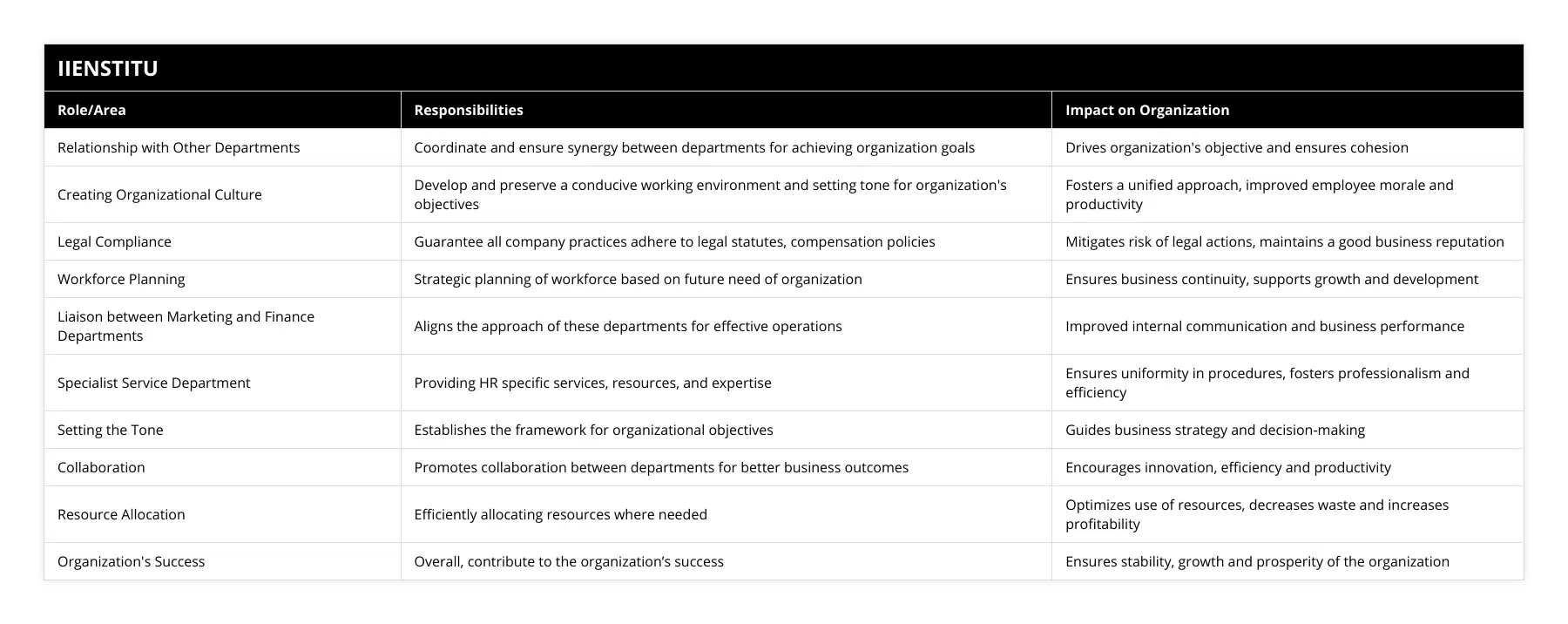
In conclusion, the principal role of Corporate HR is providing resources and support required for all departments within an organization to work together harmoniously towards the achievement of the organization's objectives. It helps nurture a unified organizational culture, sets the tone for the organization's goals, and ensures legal and compensation policies are adhered to. Corporate HR fosters collaboration and unity among various departments, leading to the overall success of the organization. The importance of a well-functioning Corporate HR informs the growing demand for HR Certificate Programs that equip HR professionals with the skills needed to drive organizational growth and success.hr certificate programs
Frequently Asked Questions
What is the role of Corporate HR in uniting departments?
.The role of Corporate Human Resources (HR) in uniting departments is critical to the success of an organization. HR professionals are responsible for creating and maintaining a cohesive work environment conducive to collaboration, and they play an essential role in bridging the gap between departments.
HR professionals must first identify any interdepartmental issues that may exist. This can be done through communication and observation. HR should strive to understand each department's dynamics and the difficulties employees may face when attempting to collaborate. Once any issues have been identified, HR can then address and remedy them.
HR can also play a role in encouraging collaboration between departments by providing resources and training. This could include creating policies and procedures for interdepartmental cooperation and workshops and seminars to teach employees how to work together effectively. HR can also provide incentives, such as recognition and rewards, to promote interdepartmental collaboration.
In addition, HR can serve as a mediator between departments to help resolve conflicts. For example, HR can help facilitate discussion and compromise between departments on workload, workflow, and job roles. HR can also provide support and guidance to ensure that all parties are in agreement and that the best interests of the organization are being taken into account.
Finally, HR can help to promote a sense of unity within the organization. This can be done through team-building exercises, social events, and company-wide meetings. These activities can help to foster a sense of camaraderie and create a more unified work environment.
Overall, HR plays a vital role in uniting departments. By understanding the dynamics between departments and providing resources, incentives, and guidance, HR can ensure that departments are working together effectively and that the organization is achieving its goals.
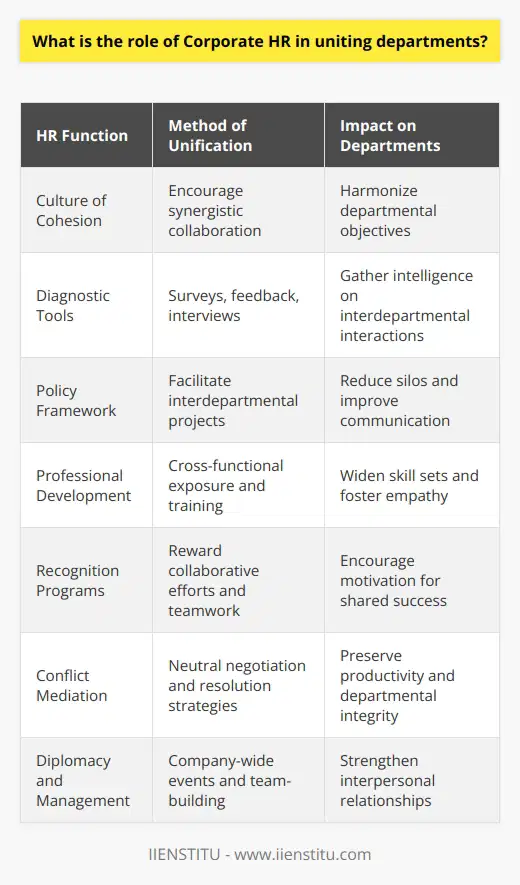
How does Corporate HR help to create a unified organizational culture?
Organizational culture is a critical factor in the success of any business. Corporate HR plays a significant role in creating a unified organizational culture. This article will discuss how corporate HR can help create a unified organizational culture.
First, corporate HR can create a unified organizational culture by developing and implementing consistent policies and procedures across the organization. These policies and procedures should promote collaboration, trust, and respect among employees. This will help ensure that all employees understand the expectations for their behavior and the values that the organization seeks to promote.
Second, corporate HR can also help create a unified organizational culture by providing employee training and development opportunities. These opportunities should focus on teaching employees how to work together, communicate effectively, and collaborate to achieve organizational goals. This will help to ensure that employees have the necessary skills to work together and create a unified team.
Third, corporate HR can also help to create a unified organizational culture by fostering an environment of inclusion and diversity. This means providing opportunities for employees to interact with each other and share their experiences and perspectives. This can help to create a sense of belonging and camaraderie, which can help to foster a unified organizational culture.
Finally, corporate HR can help to create a unified organizational culture by recognizing and rewarding employees for their contributions. This can help motivate employees and develop a culture of collaboration and respect.
In conclusion, corporate HR is essential in creating a unified organizational culture. By developing and implementing policies and procedures, providing training and development opportunities, fostering an environment of inclusion and diversity, and recognizing and rewarding employees for their contributions, corporate HR can help to create a culture of collaboration and respect that will benefit the entire organization.
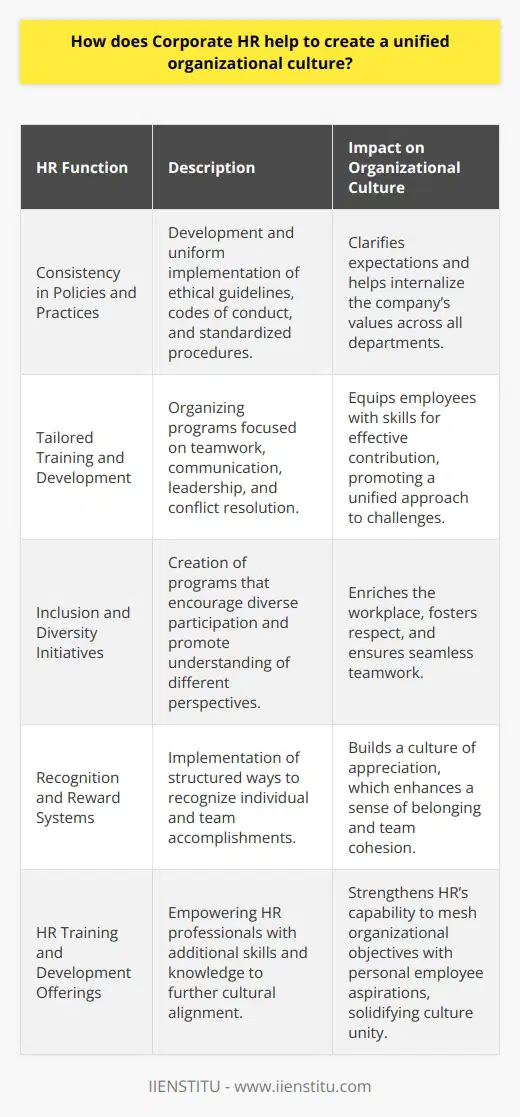
What strategies can Corporate HR use to ensure effective communication between departments?
Effective communication between departments is essential for the success of any organization, and it is the responsibility of corporate HR to ensure that communication is effective in the organization. Corporate HR can use various strategies to ensure effective communication between departments.
First, Corporate HR should ensure that all departments have adequate resources and support to facilitate effective communication. This includes providing access to communication tools such as email, video conferencing, and instant messaging. It also provides training to ensure that all employees are familiar with these tools and know how to use them effectively.
Second, Corporate HR should create clear guidelines for communication between departments. These guidelines should include expectations for communication frequency, content, and tone. Furthermore, the policies should provide clear procedures for resolving any issues that arise during communication.
Third, Corporate HR should promote collaboration between departments. This can be done through team-building activities, such as team lunches, off-site meetings, and the establishment of cross-departmental committees. Additionally, Corporate HR should encourage informal communication between departments, such as through social media, to foster a sense of community.
Finally, Corporate HR should ensure that all departments have access to effective feedback mechanisms. This includes establishing a process for resolving communication issues, providing feedback on communication performance, and creating an environment of accountability.
By implementing these strategies, Corporate HR can ensure effective communication between departments and help organizations reach their goals.

What is the role of HRM department in the achievement of corporate strategy?
Role of HRM in Strategy Implementation
The Human Resource Management (HRM) department plays a crucial role in achieving corporate strategy by ensuring the alignment of human capital with organizational goals. HRM is responsible for selecting, retaining, and developing employees whose skills and competencies contribute to the achievement of business objectives. Through strategic recruitment, HRM ensures that the organization attracts and hires the right talent needed to drive corporate strategy.
Training and Development Initiatives
HRM also designs and implements training and development programs that prepare employees for current and future roles, thereby closing skill gaps and enhancing organizational performance. These initiatives include continuous learning opportunities, career development plans, and management-training programs that foster a culture of growth and development, supporting the overall corporate strategy.
Performance Management and Appraisal
Another critical function of HRM in corporate strategy achievement is the effective management of employee performance. HRM develops and implements performance appraisal systems that measure employees' contributions to the organization and evaluate their ability to meet strategic objectives. By identifying high-potential employees and linking their performance to rewards and recognition, HRM fosters a results-driven culture that promotes organizational success.
Internal Communication and Corporate Culture
The HRM department also plays a vital role in shaping the organization's corporate culture by promoting values, beliefs, and practices that align with the business strategy. Through internal communication efforts, HRM facilitates the flow of strategic information across the organization, ensuring employees understand and commit to the company's vision and mission. By fostering a positive corporate culture, HRM actively contributes to employee engagement, motivation, and overall job satisfaction, which ultimately results in the achievement of corporate strategy.
Workforce Planning and Succession Management
Lastly, HRM actively engages in workforce planning and succession management to ensure the long-term sustainability of the organization. This involves analyzing workforce data, forecasting staffing needs, and creating talent pipelines to fill critical positions in the company. By doing so, HRM ensures that the organization has the necessary human resources to meet both current and future business demands.
In conclusion, HRM plays a vital role in achieving corporate strategy by recruiting and developing top talent, managing performance and appraisal systems, fostering a positive corporate culture, and conducting workforce planning and succession management. By aligning human capital to business objectives, HRM actively contributes to the organization's success and growth.
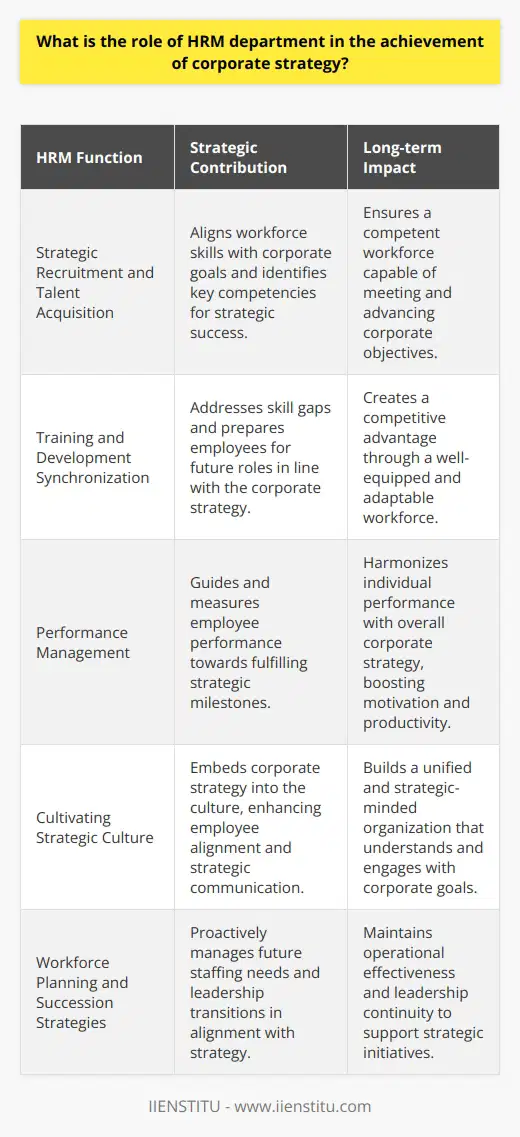
What is the role of human resource HR management in effective corporate governance?
Role of HR Management in Corporate Governance
Enhancing Organizational Performance
Human resources (HR) management plays a crucial role in effective corporate governance by attracting, developing, and retaining talent essential for achieving organizational objectives. By implementing robust HR practices and policies, companies can enhance their productivity, innovation, and overall performance, ultimately contributing to their long-term viability and success.
Ensuring Compliance and Risk Management
Additionally, HR management is responsible for ensuring compliance with relevant legal and regulatory requirements, mitigating the risk of penalties or litigation. This includes safeguarding employee rights, promoting diversity and inclusion, and implementing programs to prevent workplace discrimination, harassment, or other unethical conduct. Through these efforts, HR management contributes to creating an ethical and transparent corporate culture.
Promoting Ethical Behaviors and Integrity
One of the primary roles of HR management within corporate governance is the promotion of ethical behaviors and integrity throughout the organization. This includes designing and implementing codes of ethical conduct, providing training and resources on ethical decision-making, and ensuring managers model principled behaviors. By fostering an environment in which employees feel comfortable reporting ethical concerns, HR management can contribute to steering the organization away from unethical practices that could damage its reputation and long-term prospects.
Developing Leadership and Employee Engagement
HR management also plays a critical role in developing and nurturing effective leadership within the organization. By designing leadership development programs, offering feedback and coaching, and providing opportunities for skill-building, HR management can contribute to the growth of leaders capable of guiding the organization towards its strategic goals. Furthermore, HR management is instrumental in fostering employee engagement, through regular communication, employee recognition, and performance management practices.
Facilitating Board Oversight and Accountability
Finally, HR management supports the board of directors in their oversight and accountability functions. By providing the board with accurate and timely information on workforce trends, labor market developments, and emerging talent-related risks, HR management allows board members to make informed decisions and set strategic direction for the organization.
In conclusion, HR management's role in effective corporate governance is multifaceted, encompassing key areas such as organizational performance, compliance, risk management, ethical behavior, leadership development, employee engagement, and board oversight. Organizations that invest in strong HR management are better positioned to navigate the complex and dynamic challenges of the modern business environment and achieve long-term success.
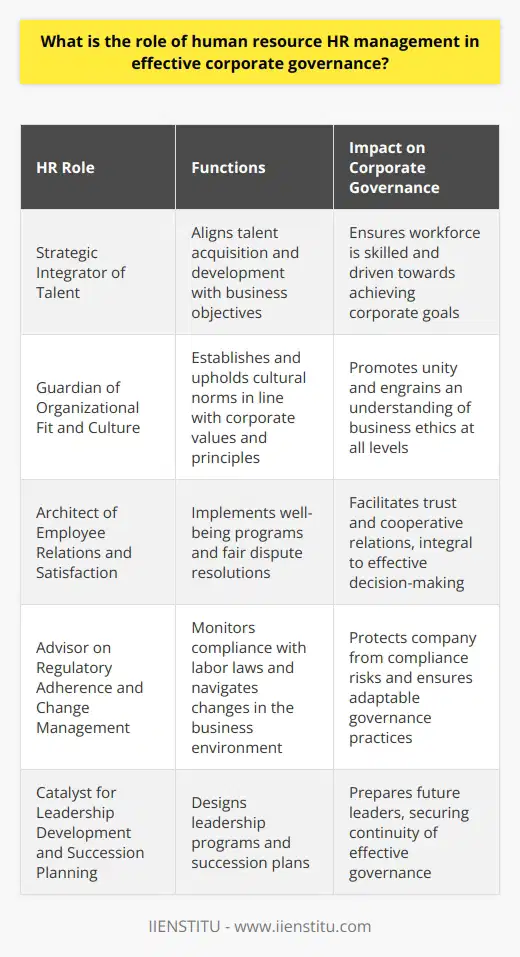
What is the relationship between HR and other departments in organization?
HR's Role in Interdepartmental Collaboration
The Human Resources (HR) department plays a critical role in establishing and nurturing strong relationships between other departments within an organization. One key aspect of this is facilitating effective communication and collaboration among various functional areas.
Creating Synergy through Coordination
HR helps develop a synchronized work environment by coordinating and integrating the activities of different departments. This might involve organizing cross-functional teams, providing necessary training or establishing a common platform for shared information, thus promoting better understanding among employees.
Nurturing Talent and Developing Skills
In order to improve the overall performance of the organization, HR works closely with other departments to identify skill gaps and provide appropriate training, and development opportunities. This ensures that employees have the expertise required to contribute effectively to their respective departments.
Addressing Conflicts and Developing Culture
Interdepartmental conflicts can arise due to miscommunication, conflicting goals or differing perspectives, and HR plays a mediatory role to resolve such issues. HR ensures a healthy organizational culture by establishing an inclusive work environment and fostering positive relationships among employees from different departments.
Aligning Goals and Performance Management
Collaboration between HR and other departments is crucial in setting organizational goals and designing performance management systems. HR ensures that the objectives of each department align with the overall strategic vision, and helps design processes to evaluate and reward performances.
Ensuring Compliance and Process Improvement
In addition to fostering interdepartmental relationships, HR works closely with various departments to ensure compliance with labor laws, industry standards, and internal policies. HR continuously identifies opportunities for process improvements and collaborates with relevant stakeholders to implement necessary changes.
In conclusion, HR plays a pivotal role in forging strong, positive relationships between different departments within an organization. By fostering effective communication, providing training and development, addressing conflicts, aligning goals, and ensuring compliance, HR contributes to a harmonious and productive work environment.
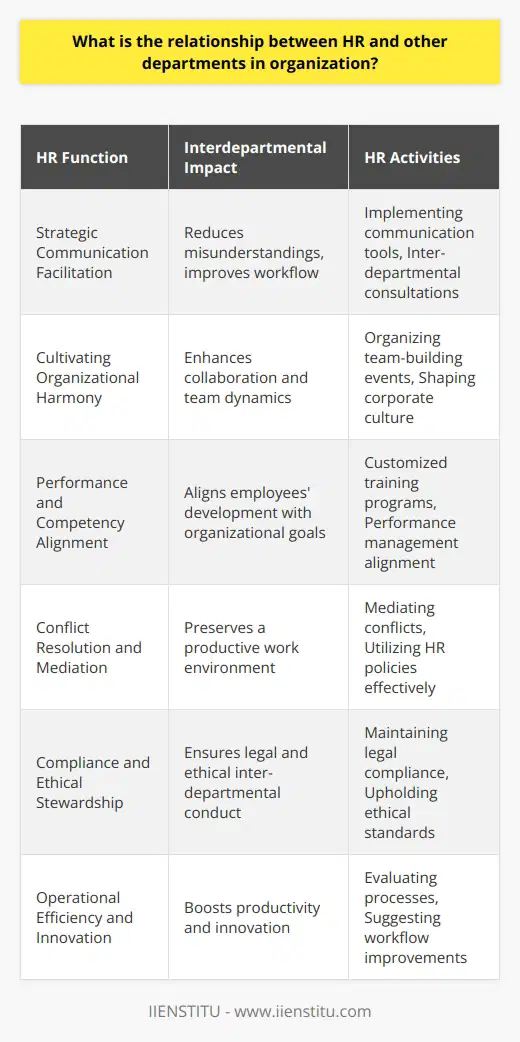
What is the role of HR department in corporate?
Role of HR Department in Corporate
Employee Recruitment and Retention
The Human Resource (HR) department plays a crucial role in corporate organizations, prominently in the acquisition and retention of employees. They develop comprehensive recruitment strategies, which include understanding the organization's needs and selecting job candidates with skills matching the desired requirements.
Training and Development
HR departments are also responsible for employee training and development. This includes identifying individual employee needs, planning regular training sessions, and developing long-term career development plans. The aim is to continuously enhance the skill set and capabilities of the workforce, benefiting both employees and the organization.
Compensation and Benefits Administration
Another essential role of HR departments lies in managing employee compensation and benefits. This involves developing comprehensive pay structures, bonus schemes, and benefits packages. HR personnel ensure that these packages are competitive within the industry, thereby attracting and retaining top talent while maintaining fiscal responsibility.
Maintaining a Positive Work Environment
HR departments work diligently to cultivate a positive work environment. They engage in promoting employee satisfaction through the administration of employee relations programs, conflict resolution, and the implementation of diversity and inclusion initiatives. This fosters a respectful and productive workplace, contributing to the overall success of the organization.
Compliance and Legal Responsibilities
Lastly, the HR department ensures that the organization is compliant with relevant labor laws and regulations. They develop sound policies and procedures to prevent workplace discrimination, protect employees' rights, and uphold ethical standards. Furthermore, HR departments manage issues related to company restructuring, lay-offs, and terminations to minimize legal risks.
In conclusion, the Human Resource department serves as the backbone for the overall success and stability of a company. They are involved in every aspect of employee management, including recruitment, training, compensation, and compliance, effectively shaping the organizational culture and workforce.
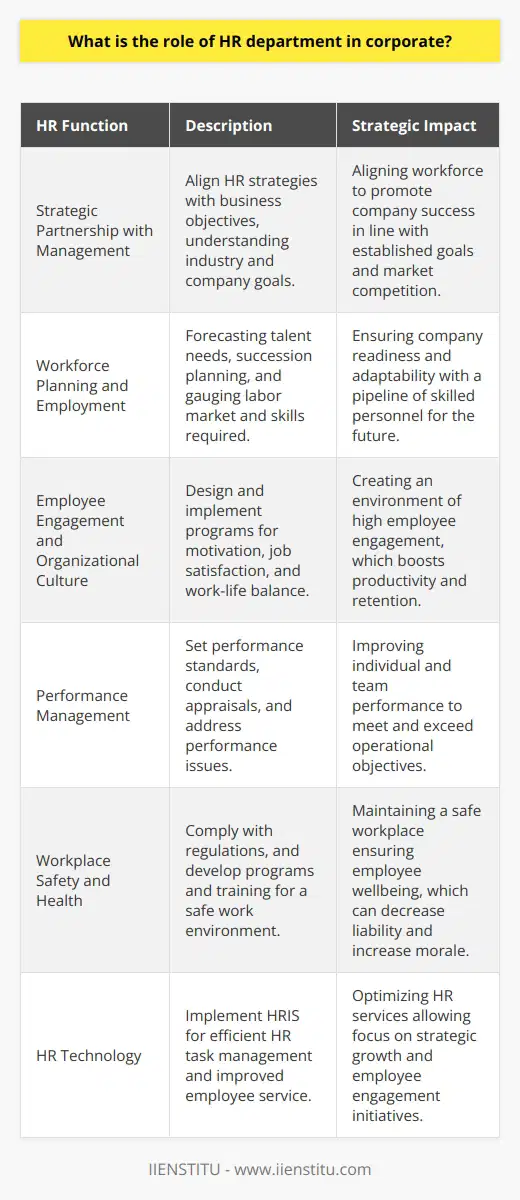
How do unions and HR work together?
Collaboration between Unions and HR
Unions and HR departments can foster a productive and mutually beneficial relationship by addressing workplace issues jointly. As organizations committed to workers' rights and well-being, unions often work closely with HR professionals to promote fair employment practices and protect employees from exploitation. They rely on communication, negotiation, and conflict resolution to arrive at mutually satisfying solutions.
Open Communication Channels
One of the critical success factors in any collaboration between unions and HR lies in establishing and maintaining open lines of communication. It is essential for both parties to engage in honest, transparent, and respectful discussions about employee issues, concerns, and expectations. By embracing a policy of openness and inclusivity, unions and HR can develop trust and work together collaboratively.
Collective Bargaining
One of the main responsibilities of unions is to represent employees in collective bargaining negotiations with management. In these situations, HR professionals often serve as the management's representatives, tasked with achieving a balance between the workers' demands and the organization's interests. By participating in such negotiations, unions and HR can work together to advance employee rights, wages, and work conditions.
Dispute Resolution
Conflicts and disputes are common in any workplace setting. Unions and HR departments must collaborate to resolve such issues effectively and efficiently. Their ability to communicate openly and respectfully, negotiate fairly, and reach mutually agreeable solutions can help create an environment in which employees feel valued and respected.
Training and Development
As part of their commitment to employee growth and development, unions and HR departments often collaborate in organizing training programs and workshops. These initiatives may include leadership training, workplace safety programs, and other professional development opportunities. By working together, unions and HR help equip workers with the skills and knowledge necessary to excel in their roles.
Compliance with Labor Laws
Both unions and HR departments are responsible for ensuring compliance with labor laws and regulations. This typically includes the implementation of policies and procedures that protect workers' rights and promote workplace safety. By working together, they can ensure that all employees are treated fairly and operate under safe conditions.
In conclusion, a cooperative relationship between unions and HR departments is essential for creating a workplace environment where employees feel secure and supported. By working together, they can address concerns, negotiate fair agreements, and ensure compliance with labor laws. Effective collaboration will ultimately benefit both employees and the organization as a whole.
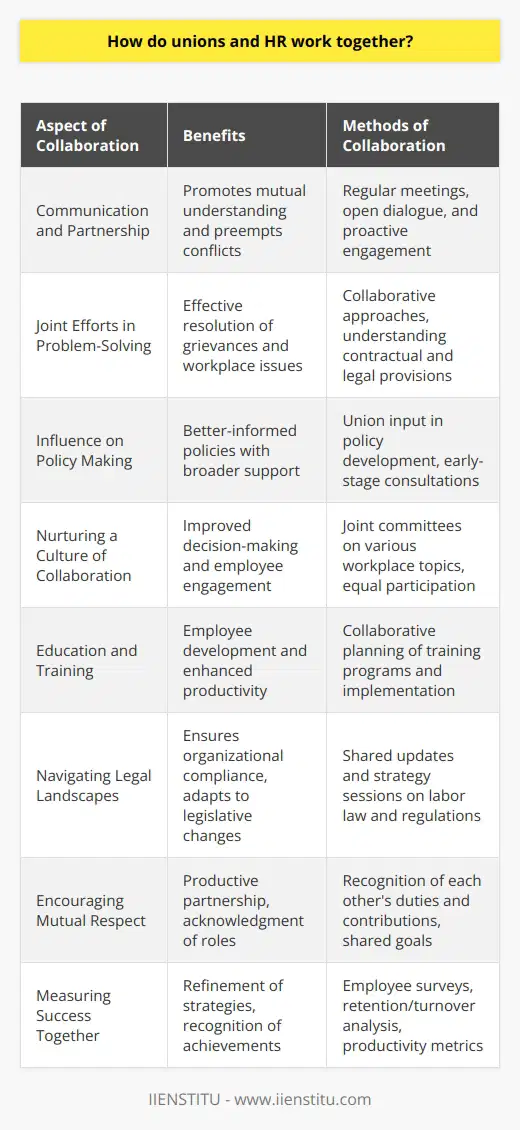
What is the role of HRM department in the achievement of corporate strategy?
Role of HRM in Corporate Strategy
Aligning HR Practices with Organizational Goals
The Human Resource Management (HRM) department plays a crucial role in the achievement of corporate strategy by ensuring that human capital is aligned with the organization's goals. HR professionals ensure that employees possess the required skills, knowledge, and abilities to perform their jobs effectively, thereby contributing to overall organizational success.
Recruitment and Selection Process
One of the primary responsibilities of the HRM department involves the recruitment and selection of the right talent. By sourcing and hiring individuals who fit well within the company culture and possess the necessary qualifications, HRM contributes to the company's growth and ability to achieve strategic objectives.
Training and Development Initiatives
To ensure that employees remain capable and adaptable to the ever-changing business environment, HRM departments frequently implement training and development initiatives. These programs, often tailored to employees' specific needs or job functions, build competencies that directly contribute to achieving the organization's goals.
Performance Management and Feedback
Another critical aspect of HRM's role in corporate strategy is performance management. The HRM department establishes performance metrics, evaluates employees against those criteria, and provides constructive feedback, enabling employees to understand and improve their performance. This continuous process ensures that employees remain engaged and accountable, enabling the organization to achieve its strategic objectives.
Reward and Recognition Systems
HRM departments also play a vital role in developing and implementing reward and recognition systems, which can motivate employees to contribute to the company's strategic goals. By offering competitive compensation packages, promotion opportunities, and various employee recognition and incentive programs, HRM departments can help foster a sense of commitment and loyalty among employees.
Employee Relations and Conflict Resolution
Lastly, the HRM department fosters a positive work environment by managing employee relations, addressing workplace conflicts, and ensuring that employees are treated fairly and equitably. By promoting a positive work culture and resolving issues proactively, HRM can help to retain top talent, reduce employee turnover, and maintain a workforce motivated to achieve the organization's strategic goals.
In conclusion, the HRM department plays a pivotal role in the achievement of corporate strategy by ensuring that human capital is aligned with organizational goals. By effectively managing recruitment, training, performance management, reward systems, and employee relations, HRM helps organizations realize their strategic objectives and maintain a competitive edge.

What are the key responsibilities of the HR department in achieving corporate strategic goals?
Role of HR Department in Strategic Goals
The HR department plays a critical role in contributing to the achievement of an organization's strategic goals. One of its essential responsibilities is workforce planning, which entails developing talent acquisition and retention strategies to ensure a skilled and motivated labor force. By aligning staffing plans with the organization's strategic objectives, HR can help bridge the gap between current workforce capabilities and future business needs.
Performance Management and Employee Development
Another key responsibility of HR in achieving corporate strategic goals is performance management. This involves developing and implementing processes to evaluate employee performance and contributions to organizational success. HR also oversees employee development initiatives, such as training programs, workshops, and mentorship opportunities aimed at enhancing employees' current skill sets and preparing them for future roles within the company.
Building an Engaging Culture
Cultivating a positive organizational culture is vital to achieving corporate strategic goals. The HR department is responsible for creating an engaging work environment that promotes employee satisfaction, commitment, and motivation. This may include the development of recognition programs, team-building activities, and effective communication strategies. By fostering a healthy corporate culture, HR can directly influence employees’ overall performance and commitment to organizational objectives.
Facilitating Organizational Change
In an ever-changing business landscape, the HR department must be nimble and adaptive. It is responsible for supporting organizational change by creating and executing strategies that allow the company to respond effectively to new challenges and opportunities. This may involve redefining job roles, designing new organizational structures, or providing employees with the necessary tools and resources for adapting to new processes or technology.
Aligning HR Practices with the Strategic Goals
Finally, the HR department needs to ensure that all human resources policies and practices are in sync with the organization's strategic goals. This includes safeguarding that compensation and benefits packages are competitive, developing effective workforce diversity and inclusion strategies, and fostering an environment that encourages innovation and continuous improvement. Through these efforts, HR can enable the organization to attract, develop, and retain high-performing employees crucial for achieving corporate strategic goals.
In conclusion, the HR department’s key responsibilities in achieving corporate strategic goals encompass workforce planning, performance management, employee development, facilitating organizational change, and aligning HR practices with the organization's objectives. By fulfilling these roles effectively, HR can significantly enhance the company's ability to attain success and maintain a competitive edge in the marketplace.
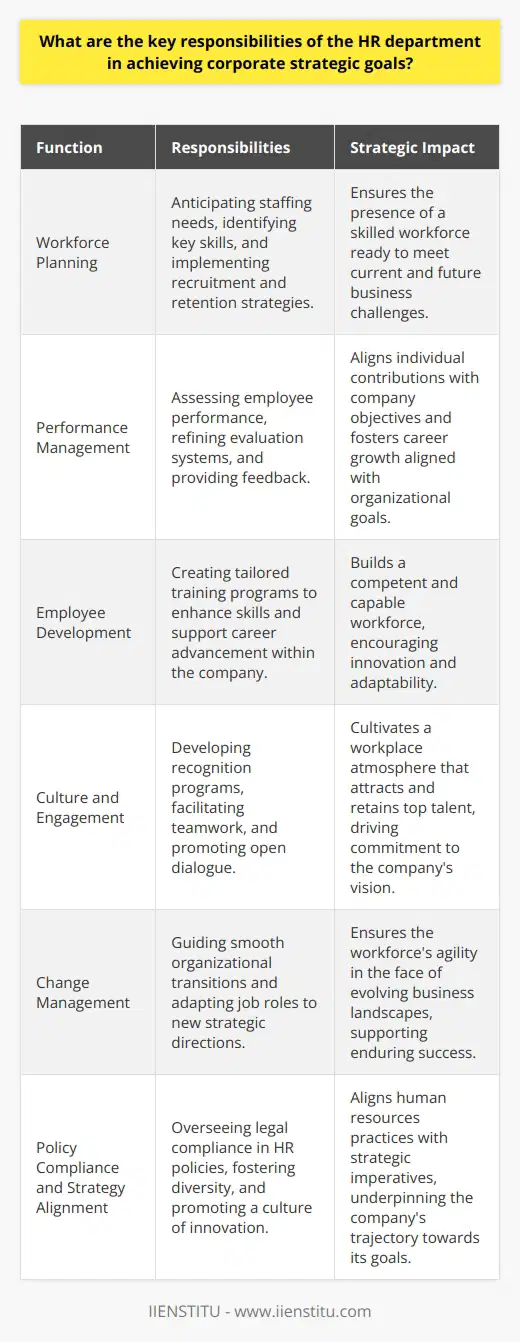
How do HRM practices contribute to an organization's overall performance?
Role of HRM Practices on Business Performance
Effective human resource management (HRM) practices play a crucial role in an organization's overall performance. HRM practices encompass various aspects, including recruitment and selection, as well as employee development and retention, which contribute to an organization's long-term success.
Recruitment and Selection
The quality of an organization's workforce largely depends on the effectiveness of its recruitment and selection strategies. HRM practices focusing on attracting and selecting the right candidates ensure that organizations have skilled and competent employees, essential for achieving organizational goals and objectives.
Employee Development
Another important function of HRM practices is employee development, which focuses on providing employees with adequate training, mentoring, and growth opportunities. By investing in employee development, organizations can enhance their workers' skills, boost productivity, and foster a competitive edge in the marketplace.
Retention and Employee Satisfaction
Retention of top-performing employees is vital for an organization's sustained growth and success. HRM practices that promote employee satisfaction, such as competitive compensation packages, beneficial working conditions, and equitable performance appraisals, help to retain valuable employees, reducing turnover and its associated costs.
Effective Communication
HRM practices that encourage effective communication within organizations help to clarify expectations, establish a collaborative work environment, and foster enhanced employee engagement. Open communication channels contribute to better decision-making processes and higher levels of trust and commitment from employees.
Organizational Culture
One significant aspect of HRM practices often overlooked is the establishment and nurturing of a strong organizational culture. A robust company culture that aligns with an organization's values and goals positively influences employee motivation, commitment, and overall performance.
In conclusion, HRM practices that focus on recruitment and selection, employee development and retention, effective communication, and a strong organizational culture greatly contribute to an organization's overall performance. By adopting such HRM practices, organizations can ensure a competent workforce, improved productivity, and sustained success in today's competitive business environment.
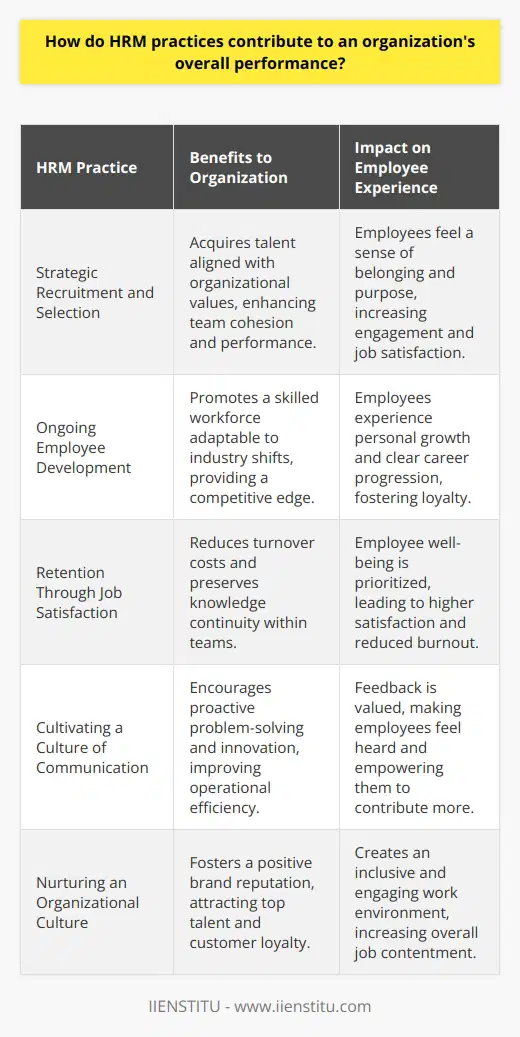
In what ways does effective HR management enhance corporate governance within a company?
Role of HR Management in Corporate Governance
Effective HR management plays a significant role in enhancing corporate governance within a company. By implementing well-defined HR policies and practices, companies can ensure that they adhere to regulatory requirements and ethical standards. This, in turn, leads to increased trust and confidence from stakeholders, including employees, investors, and customers.
Recruitment and Selection
One key area where HR management contributes to corporate governance is through the recruitment and selection of employees. By implementing rigorous recruitment processes and stringent background checks, HR ensures that the company hires only those individuals who have the necessary qualifications, experience, and integrity. This minimizes the risk of corporate fraud, misconduct, or other unethical behavior from employees.
Training and Development
Another crucial aspect of effective HR management is the provision of continuous training and development programs for employees in relevant areas such as ethics, compliance, and risk management. By equipping employees with the necessary knowledge and skills to uphold the company's values, HR fosters a culture of integrity and responsiveness, which strengthens the overall corporate governance framework.
Performance Management and Reward Systems
Effective HR management also involves the design and implementation of appropriate performance management and reward systems, which can help a company encourage desired behaviors and discourage detrimental ones. By aligning employee objectives with the company’s goals and values, HR promotes better decision-making and risk management practices, thus enhancing corporate governance.
Managing Employee Relations
Maintaining open and transparent communication with employees is another area where HR management strengthens corporate governance. By effectively managing employee relations and resolving conflicts in a fair and consistent manner, HR builds trust and commitment among employees. This helps to foster a positive work environment in which employees feel motivated to act in the best interests of the company.
Ensuring Compliance
Lastly, HR management plays a crucial role in ensuring the company’s compliance with labor laws and other legal requirements. By staying up-to-date with regulatory changes and working closely with legal and compliance teams, HR helps to prevent violations that could potentially damage a company’s reputation or lead to legal sanctions.
In conclusion, effective HR management contributes significantly to the enhancement of corporate governance within a company. By promoting ethical behavior, ensuring compliance with regulations, and fostering a culture of trust and accountability, HR helps companies protect their reputations and achieve long-term success.
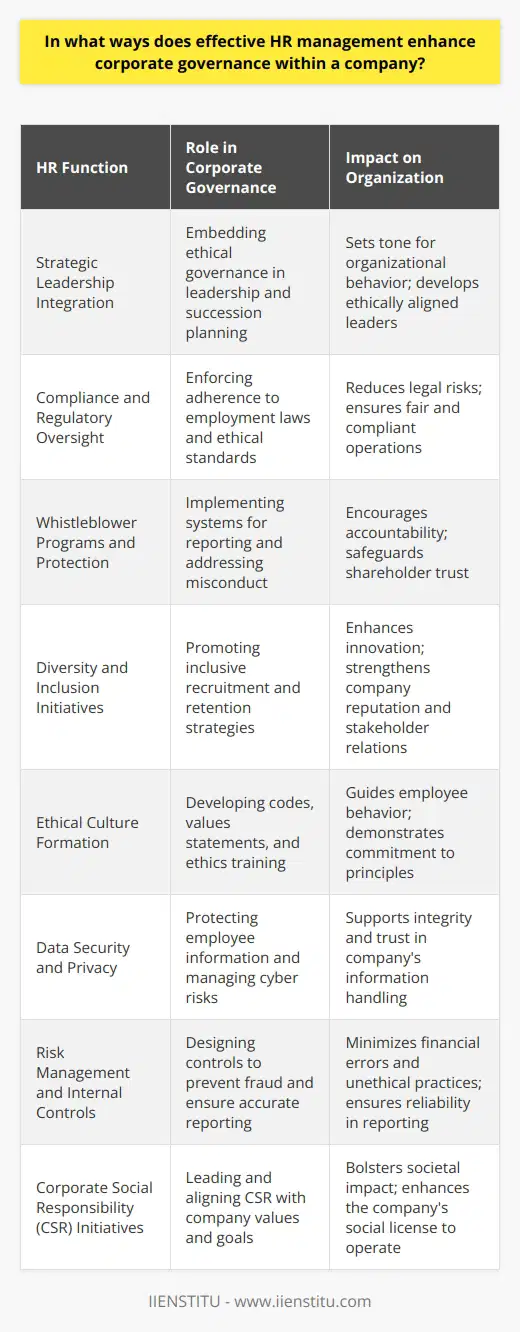
What are the main functions of the HR department in supporting a company's strategic goals?
**Role of HR in Strategic Planning**
The Human Resources (HR) department performs multiple crucial functions to support an organization's strategic goals. Primarily, the HR department is responsible for acquiring, developing, and retaining talent that aligns with the company's objectives.
**Talent Acquisition and Management**
One of the principal functions of the HR department is talent acquisition and management. This entails identifying staffing requirements, recruiting top talent, and implementing onboarding programs to integrate new employees into the organization. To achieve strategic goals, HR must align recruitment and selection processes with the company's objectives, ensuring the workforce possesses the necessary skills, knowledge, and expertise.
**Employee Development**
Another pivotal function of the HR department is employee development. This involves creating tailored training and development programs to enhance the competencies and abilities of employees in support of the company's strategic goals. The efficient development of human capital is essential for organizations to maintain a competitive advantage in the market.
**Performance Management**
To ensure employees remain committed to the company's strategic goals, the HR department is in charge of developing and implementing performance management systems. These systems aim to evaluate employee performance, set realistic targets, and provide constructive feedback, fostering a workforce culture of continuous improvement and engagement with organizational objectives.
**Employee Retention**
The HR department also plays a crucial role in employee retention, focusing on maintaining job satisfaction, motivation, and morale. To achieve this, HR designs and implements fair compensation, benefits, and reward systems that recognize employees' efforts and contributions. Moreover, by fostering a supportive and inclusive work environment, HR can help minimize employee turnover, reducing recruitment costs and ensuring the stability of the workforce.
**Legal Compliance**
Lastly, HR is responsible for ensuring the organization's compliance with labor laws and regulations. This entails staying up-to-date with legal requirements, implementing policies and procedures to minimize risks, and managing employee relations to avoid conflicts and disputes. In doing so, the HR department contributes to a stable and legally compliant operating environment, enabling the organization to focus on pursuing its strategic goals.
In conclusion, the HR department plays an integral role in supporting a company's strategic goals through talent acquisition, employee development, performance management, employee retention, and legal compliance. As a result, organizations must prioritize HR functions as essential components of their overall strategic planning process.
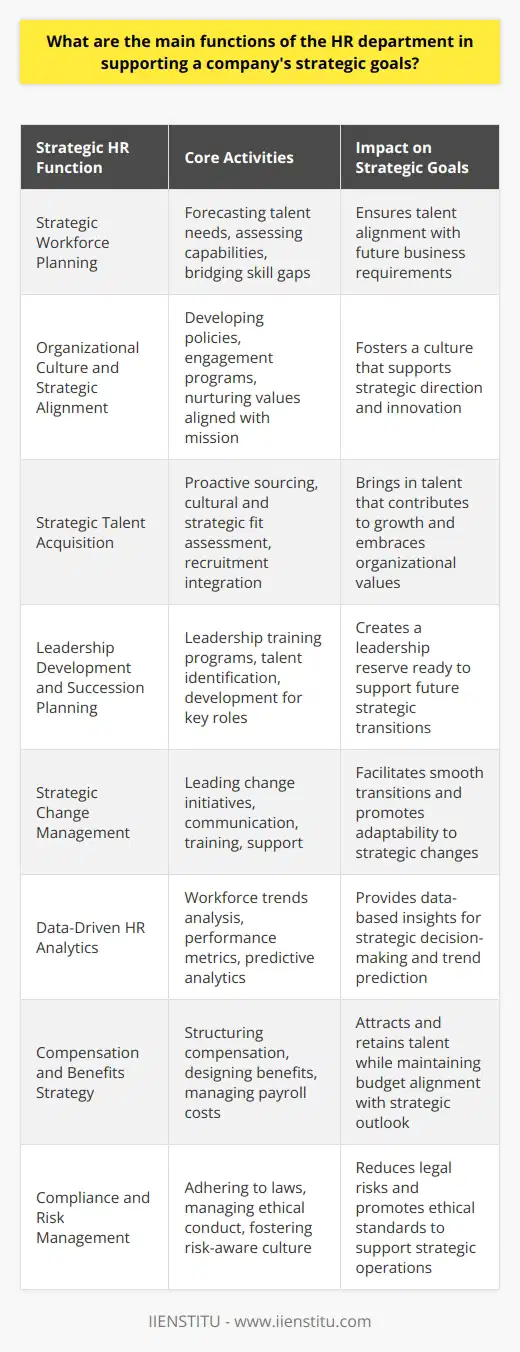
How does HR collaborate with various departments to ensure effective implementation of corporate policies?
Collaboration Between HR and Different Departments
To effectively implement corporate policies, the Human Resources (HR) department must closely collaborate with various departments within an organization. This close collaboration ensures a full understanding and incorporation of policies, while promoting a consistent message across all employee groups.
Aligning HR Objectives with Departmental Goals
At the core of this collaboration is the alignment of HR objectives with departmental goals. By working closely together during policy creation, HR can ensure a seamless integration of policies with the overall goals of the organization. Moreover, departmental leaders can identify any potential challenges or areas of improvement to refine proposed policies.
Training and Communication
One crucial aspect of collaboration is the training and communication process. HR must take the lead in communicating policy updates, providing training programs, and supplying necessary materials to departmental managers. In-turn, these managers are responsible for disseminating the information within their respective teams and ensuring proper adherence.
Performance Management and Feedback
HR can work with departmental managers to support the application of corporate policies by integrating them into performance management systems. Regular feedback and performance evaluations can ensure employees are aware of policy expectations and give them the opportunity to improve compliance. Furthermore, HR can gather feedback from departmental leaders and teams to reassess corporate policies and make necessary adjustments.
Policy Compliance and Monitoring
Finally, effective collaboration between HR and various departments can aid in policy compliance and monitoring. HR can implement monitoring systems to track the implementation and effectiveness of corporate policies, while departmental managers can reinforce their application and compliance in daily processes.
In conclusion, effective collaboration between HR and different departments in the organization leads to a comprehensive understanding of corporate policies, an integrative approach to training and communication, and a robust performance management system. Moreover, consistent monitoring and feedback systems ensure that corporate policies are implemented efficiently and adjusted as needed.
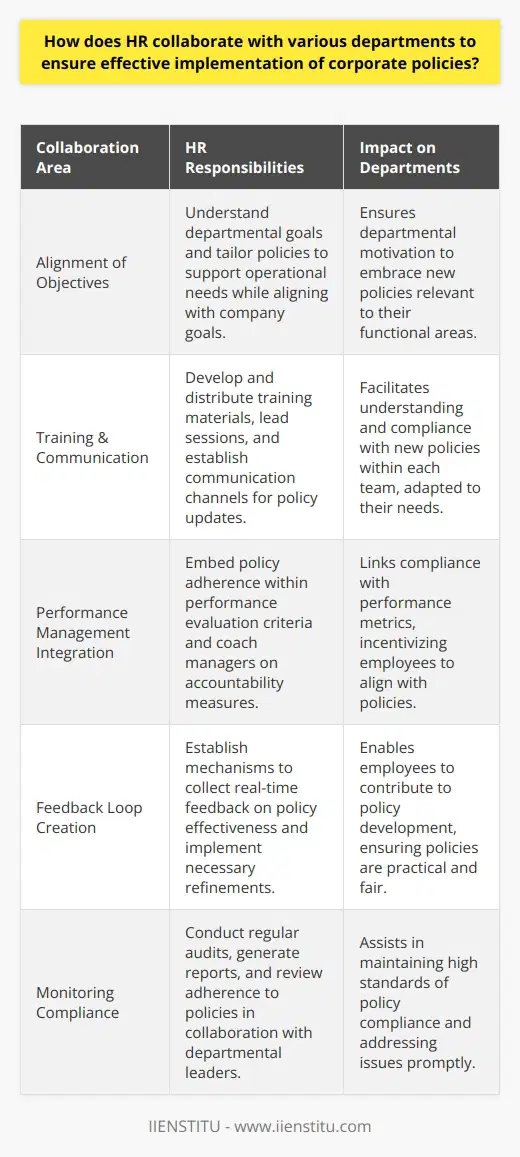
What role does HR play in promoting and upholding ethical standards across an organization?
Role of HR in Maintaining Ethical Standards
Creating a Positive Culture
Human Resources (HR) plays a critical role in promoting and upholding ethical standards across an organization. Primarily, HR ensures that a positive organizational culture is established and maintained, where employees understand and adhere to company values and ethical principles. The creation of a strong ethical culture within an organization begins from the recruitment process, with HR selecting candidates whose values align with the company's, ultimately fostering an environment that promotes ethical behavior.
Developing Policies and Procedures
Another essential function of HR in upholding ethical standards involves the development and implementation of policies and procedures that guide employee conduct. HR is responsible for creating a comprehensive code of conduct, which clearly outlines the expected behavior of employees and the consequences of unethical actions. Additionally, HR must ensure that all employees receive proper training on these policies to ensure a clear understanding of the importance of ethical behavior in the workplace.
Addressing Ethical Concerns
HR is also responsible for addressing any ethical concerns that employees may have and acting as a neutral party in instances involving questionable conduct. By creating reporting mechanisms, such as anonymous hotlines and open-door policies, HR can provide employees with a safe and discreet way to voice their concerns. In doing so, HR demonstrates the company's commitment to ethical practices and provides reassurance to employees that their concerns will be taken seriously and that appropriate action will follow.
Continuous Improvement and Monitoring
Lastly, HR's role in promoting and upholding ethical standards includes monitoring the effectiveness of the organization's ethics program and looking for ways to continuously improve the system. This may involve updating policies and procedures as needed, conducting regular audits, and reassessing employee training programs. Furthermore, HR can gather feedback from employees and utilize this information to identify potential areas of concern or improvement in the organization's ethical standards.
In conclusion, HR plays a vital role in promoting and maintaining ethical standards across an organization through a range of activities, including fostering a positive culture, developing policies and procedures, addressing concerns, and ensuring continuous improvement. By undertaking these responsibilities, HR contributes to the establishment of a strong ethical foundation within the company, resulting in a more harmonious and successful workplace.
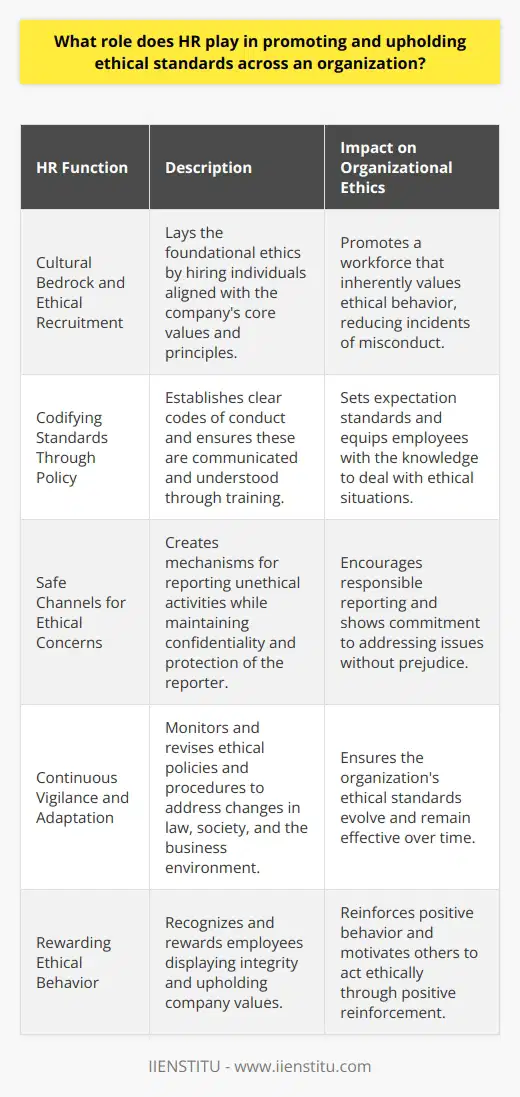
What is the role of HRM in fostering a diverse and inclusive workplace culture?
Role of HRM in Promoting Diversity and Inclusion
Creating a diverse and inclusive workplace culture is essential for organizations to enhance productivity, employee satisfaction, and talent retention. Human Resource Management (HRM) plays a critical role in promoting diversity and inclusion by executing a range of strategies and initiatives.
Recruitment and Selection
HRM implements unbiased recruitment and selection processes to ensure that a diverse group of candidates is assessed fairly. This includes using inclusive job descriptions, advertising in diverse networks, and employing diverse selection panels to minimize bias and promote equal opportunities.
Training and Development
HRM's responsibility extends to providing training and development programs that enlighten employees about the importance of diversity and inclusion. This involves offering workshops, seminars, and online training related to unconscious bias, cultural competency, and communication skills to foster a more inclusive work environment.
Policy Formulation
HRM creates policies that promote a diverse and inclusive workplace culture, such as anti-discrimination, equal opportunities, and reasonable accommodation policies. These policies communicate the organization's commitment to diversity and inclusion, providing a framework for employees to adhere to and uphold these values.
Employee Engagement
HRM seeks input and commitment from employees to create a more inclusive workplace. This includes establishing diversity and inclusion committees, implementing employee feedback mechanisms, and engaging in regular conversations with staff about diversity-related issues.
Mentoring and Sponsorship
HRM also supports mentoring and sponsorship initiatives that enable employees from diverse backgrounds to develop professionally and advance within the organization. These programs provide opportunities for employees to receive guidance, develop skills, and build networks that can accelerate their careers.
Workplace Flexibility
To encourage a diverse and inclusive workplace, HRM facilitates workplace flexibility initiatives such as remote work, flexible hours, and job-sharing. This enables employees with varying needs, such as those with caregiving responsibilities or disabilities, to participate in the workplace effectively and enhance their productivity.
Recognizing and Celebrating Diversity
Lastly, HRM plays a role in organizing events and initiatives that celebrate and acknowledge the diversity within the organization. This can include cultural events, awareness campaigns, and recognizing the achievements of employees from diverse backgrounds.
In conclusion, HRM is pivotal in fostering a diverse and inclusive workplace culture by implementing effective recruitment, training, policies, employee engagement, mentoring, and recognition strategies. By doing so, organizations can benefit from increased productivity, employee satisfaction, and talent retention.
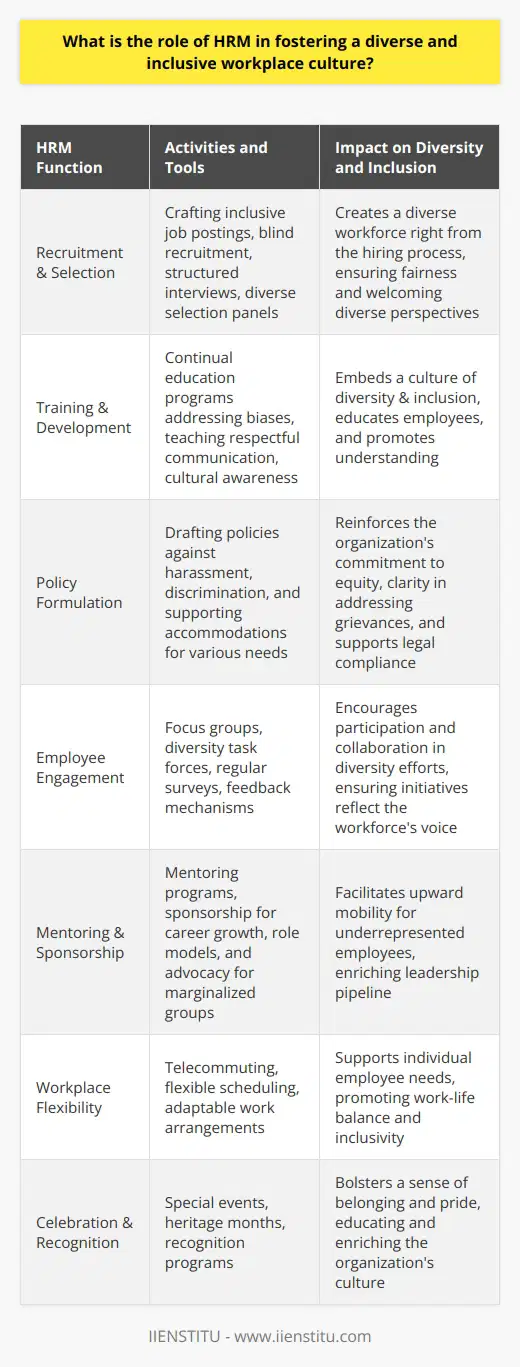
How does the HR department collaborate with senior management to achieve organizational objectives?
Defining Organizational Objectives
The HR department plays a critical role in collaborating with senior management to achieve organizational objectives. Defining these objectives is the first responsibility of the HR department. The HR team contributes by ensuring that the goals align with the company's values, culture, and overall mission. It further facilitates setting performance indicators and targets that guide the company towards achieving the objectives.
Aligning HR Practices with Objectives
Once the organizational objectives have been established, the HR department designs various programs and practices to align the workforce with these goals. Workforce planning, recruitment, onboarding, and employee training are developed to ensure they reflect the organizational objectives. The HR team effectively communicates these practices to senior management, fostering understanding and buy-in from top-level decision-makers.
Performance Management and Evaluation
The HR department further collaborates with senior management to implement a robust performance management system. This system establishes clear expectations and KPIs (key performance indicators) for all employees, ensuring that staff efforts align with the organizational objectives. The HR team works closely with senior management to create performance evaluation criteria. Regular performance reviews offer insights into whether the company's workforce is moving toward set targets and allow for adjustments when necessary.
Employee Motivation and Retention
Maintaining employee motivation and retention is critical to achieving organizational objectives. The HR department crafts policies and practices to foster an engaging work environment. Examples include competitive compensation packages and benefits, growth opportunities, and a positive work culture. Senior management collaborates with the HR department to promote these practices.
Continuous Improvement
Lastly, the HR department actively seeks feedback from senior management to identify areas requiring improvement. The HR team uses this information to develop and implement strategies to enhance the effectiveness of the workforce, positively impacting organizational objectives.
In conclusion, the HR department collaborates closely with senior management in various aspects, such as defining organizational objectives, aligning HR practices, implementing performance management systems, promoting employee motivation and retention, and striving for continuous improvement—all aimed at achieving organizational objectives. These collaborative efforts lead to a more efficient, productive workforce that supports the overall success of the organization.
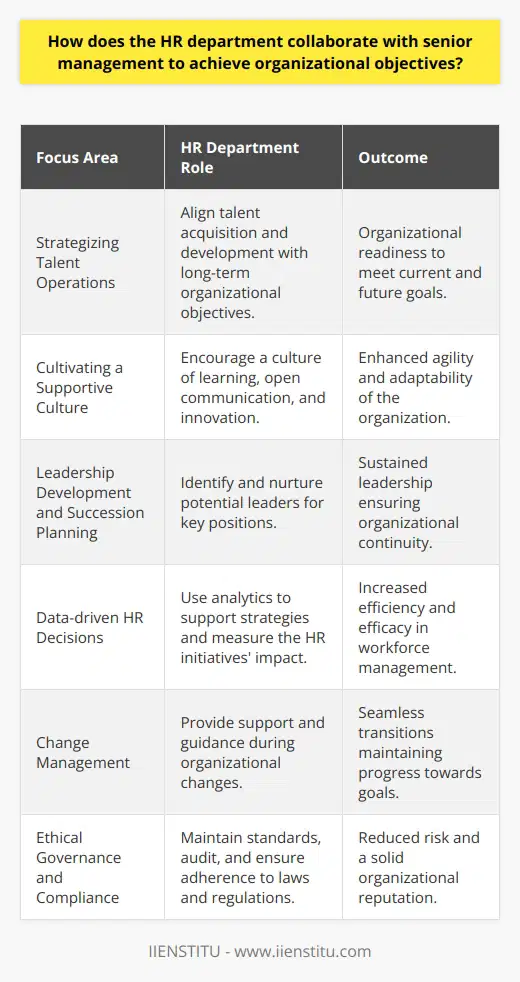
In what ways does HR support employee development and retention to ensure a motivated and skilled workforce for the organization?
Employee Development Initiatives
One pivotal aspect of human resource (HR) support for employee development lies in continuous learning opportunities that organizations provide for their workforce. By offering professional training programs, workshops, and seminars, HR departments play a crucial role in honing the skills of their employees. These opportunities not only enhance employees' professional growth but also foster a culture that values learning and development.
Mentorship and Skill Development Programs
Additionally, HR departments often implement mentorship and skill development programs that match employees with experienced professionals who can guide and support them in their career journey. Through these partnerships, employees gain valuable insights and develop essential industry-specific expertise. Moreover, such tailored guidance contributes to positive employee engagement and motivation.
Performance Management Systems
HR departments also establish well-defined performance management systems that set clear expectations and provide regular feedback on employees' progress. These systems promote open communication between managers and employees, enabling a proactive approach to addressing performance issues. Consequently, this leads to increased job satisfaction and reduced turnover rates among the workforce.
Retention Strategies
Furthermore, HR departments' role extends to developing retention strategies that focus on understanding and addressing the needs of their employees. These strategies may include offering competitive compensation packages, attractive benefits, flexible work arrangements, and various wellness initiatives. By effectively catering to employee preferences and needs, HR departments contribute to maintaining a motivated and skilled workforce that is committed to the organization.
Employee Recognition Programs
Lastly, HR departments frequently develop employee recognition programs that celebrate and reward the achievements and contributions of their workforce. By acknowledging employees' efforts, organizations cultivate a sense of belonging and pride, which positively contributes to their overall motivation and job satisfaction. This approach also enhances employee retention, as recognized and valued employees tend to remain loyal to their employers.
In conclusion, HR departments play an integral role in supporting employee development and retention through various initiatives, including continuous learning opportunities, mentorship programs, performance management systems, retention strategies, and recognition programs. These efforts result in a motivated and skilled workforce that ultimately benefits the organization's overall success and competitiveness.
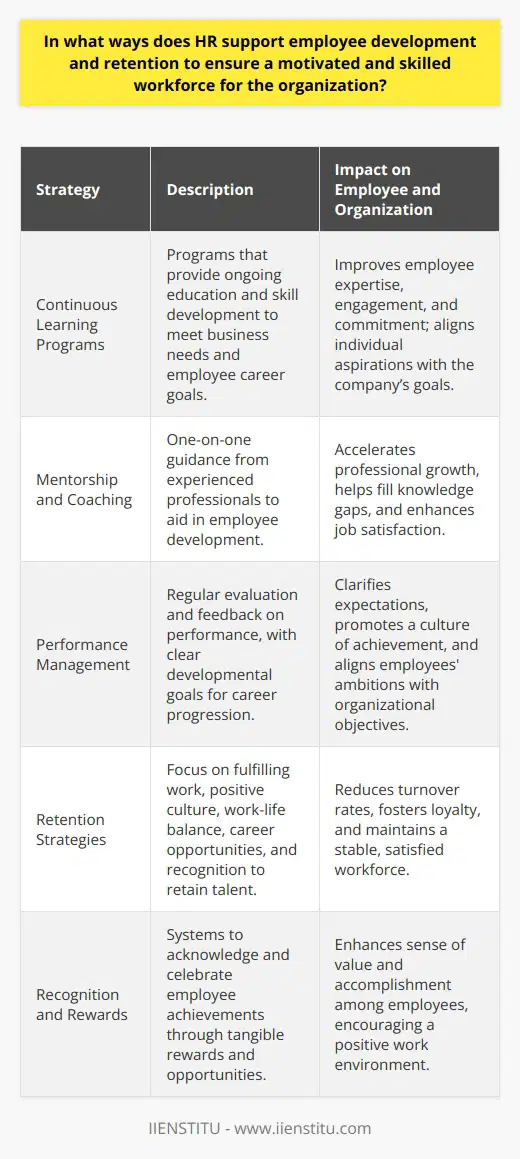
What is the role of HRM in facilitating effective decision-making and problem-solving processes in an organization?
Role of HRM in Decision-Making
Human Resource Management (HRM) plays an instrumental role in advancing effective decision-making in organizations. By gathering and analyzing relevant data, HRM aids in informed decision-making. HRM's key tasks include collecting data related to employee performance, absenteeism, and turnover rates. This data is crucial for management, guiding them in making strategic decisions like assigning roles, deciding promotions, and carrying out performance appraisals.
HRM's Role in Problem-Solving
Additionally, HRM is instrumental in problem-solving within an organization. HR managers, through employee feedback and regular performance reviews, can identify potential challenges and arduous tasks. They can then suggest ways of enhancing employee efficiency and job satisfaction. Moreover, by conducting conflict resolution and mediating in cases of disputes, HRM plays a critical role in ensuring smooth operations, thereby providing amicable solutions to internal issues.
Involvement in Employee Development and Training
HRM also contributes to effective decision-making through employee development and training. By pinpointing performance gaps and tailoring training programs to bridge them, HRM aids in optimal workforce utilization. This results in enhanced productivity and improved workplace results. Thus, HRM not only succeeds in fostering an organization's growth but also ensures its sustainability by nurturing a competent workforce.
Influence on Organizational Culture
Lastly, HRM is pivotal in shaping a company's organizational culture. Effective HR practices can foster an environment that promotes collective decision-making and encourages open communication. This transparency makes the problem-solving process faster and more efficient, resulting in better results for the organization.
In conclusion, HRM plays a significant role in effective decision-making and problem-solving processes in an organization. Through strategic management of human resources, HRM ensures that all decisions align with the organization's goals and objectives, thereby driving its success.
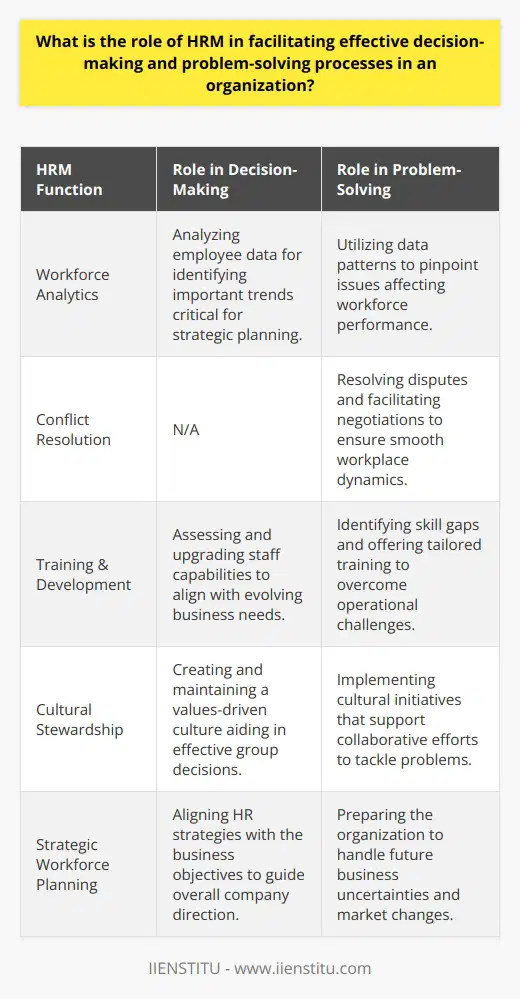
How does the HR department ensure alignment between employee goals and corporate objectives?
HR's Role in Goal Alignment
The Human Resources (HR) department plays a vital role in aligning employee goals with corporate objectives. They start this process by interpreting and communicating company goals. HR explicitly articulates the company's mission, vision, values, and strategic plans to all employees.
Strategic Recruitment
For robust alignment, HR employs strategic recruitment. They hire individuals whose personal aims fit well with company goals. They seek talent that not only have the required skills but also share the business's values and vision.
Training and Development
Next, HR invests in training and development. They provide resources for employees to acquire necessary skills and knowledge. This encourages employees to achieve personal goals, which benefits the company subsequently.
Performance Management
But alignment doesn't end there; effective performance management is key. HR sets key performance indicators (KPIs) that reflect corporate objectives. Thus, they guide employees to focus on tasks that contribute to the company's goals.
Feedback and Recognition
Additionally, HR maintains an open feedback mechanism. Constructive criticism and rewards fortify alignment. They ensure employees understand how their personal contributions impact the organization.
Career Path Planning
Finally, the HR department facilitates career path planning. This includes opportunities for job rotations, promotions, and leadership roles. By fostering growth, HR aligns personal satisfaction with corporate success.
In conclusion, HR ensures alignment between employee goals and corporate objectives by a multi-faceted approach. It ranges from the initial recruitment stage to ongoing performance management and career path planning. In this way, they work to achieve harmonious co-existence of both employee satisfaction and company success.
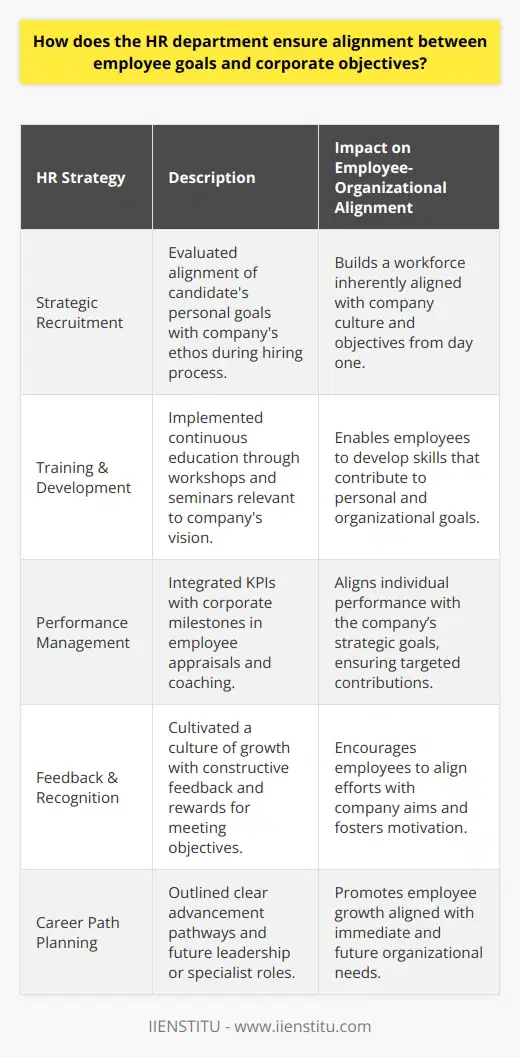
In what ways does HRM contribute to fostering innovation and creativity within an organization?
HRM's Role in Bolstering Innovation and Creativity
Human Resource Management (HRM) can play an essential role in fostering creativity and innovation in organizations. By managing the organization's talent pool, HR managers can cultivate a culture of creativity and encourage innovative thinking.
Job Design and Recruitment Influence
HRM's contribution to innovation starts with job design and recruitment. Here, HRM specialists can ensure that the organization hires individuals with varying skill sets and backgrounds. The diverse perspectives these individuals bring can fuel creative problem-solving and innovation.
Initiatives for Continuous Learning
Continuous learning initiatives are a further contribution HRM provides. By providing training and development initiatives, HRM encourages employees to learn new skills, thus enabling them to approach problems creatively. Developing an environment that promotes lifelong learning nurtures innovation.
Performance and Reward Systems
Performance and reward systems managed by HRM can also foster innovation. Recognizing and rewarding innovative efforts can motivate a culture of continuous improvement. Workers will be more likely to take risks and put forward innovative ideas if they see that creativity is valued.
Career Development Activities
HRM's role does not stop at hiring and training. Career development activities foster a long-term commitment to innovation. By providing pathways for internal mobility, HRM can ensure employees stay engaged and motivated. This, in turn, promotes a climate where creative ideas are generated and valued.
Conducive Organizational Climate
Lastly, a conducive organizational climate can contribute significantly to enhancing innovation. Through effective HRM, an environment that values open communication, trust, risk-taking, and learning can be fostered, setting the stage for creativity and innovation.
In conclusion, HRM can contribute significantly to the enhancement of innovation and creativity in an organization. By effectively managing and developing human resources, HRM can cultivate and maintain a supportive environment conducive to creativity and innovation.
